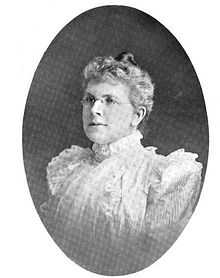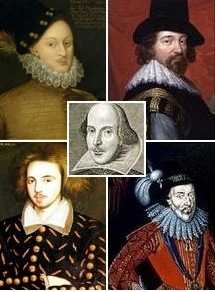Elizabeth Wells Gallup

Elizabeth Wells Gallup (1848, Paris, New York – 1934) was an American educator and exponent of the Baconian theory of Shakespearian authorship.
She was born Elizabeth Wells, and studied at Michigan State Normal College (now Eastern Michigan University), the Sorbonne and the University of Marburg. She taught in Michigan for some twenty years and became a high school principal. She used her married name Gallup but retained her maiden name, Wells.
She was interested in the life and work of Francis Bacon and, together with her sister Kate Wells, initially worked on the theories of Dr Orville Ward Owen. She subsequently became convinced of the use of the "biliteral cipher" in early Shakespeare printing to conceal messages concerning the authorship of the works and other statements about the secret history of the times. This type of cipher, also known as Bacon's cipher, had been discussed in Bacon's work. It depended on the use of two distinct typefaces within the same text to conceal messages.
Gallup came to this conclusion in 1895. In subsequent years she published a large body of literature claiming to have uncovered deciphered content in the work of Bacon, Shakespeare and others.
In later years her work was largely sponsored by Colonel George Fabyan at his Riverbank Laboratories in Geneva, Illinois. Fabyan, who had also funded Owen's work, supported a research staff working on her theory, which initially included the cryptographers William Friedman and Elizabeth Friedman. During her time at the laboratories she published many books containing decipherments of hidden messages in the work of Bacon and other writers. Her decipherments "discovered" that Bacon was the son of Queen Elizabeth and the heir to the throne. He was also discovered to be the author of the works of Christopher Marlowe, George Peele and Robert Burton. Gallup also published the play The Tragedy of Anne Boleyn which was supposed to have been hidden in cipher-form in Bacon/Shakespeare's works.[1]
The Friedmans later published a careful study of her theory showing that the range of type forms used in the printing of the works of Shakespeare conformed to the normal printing practices of the time, meaning a lot of different fonts were used in an apparently haphazard manner. They report outside experts examined the letter fonts used in the printing of Shakespeare's plays and concluded that, with few exceptions, it was not possible to unambiguously separate them into two groups, as the Bacon bi-literal cipher requires. Also that none of Mrs. Gallup's decode assistants at Riverbank were ever able to duplicate her work. The Friedmans concluded that in attempting to use Bacon's bi-literal cipher to decode Shakespeare's works the variable fonts allowed Mrs. Gallup in practice great freedom in selecting most letters of her message with the result that she found "what it was she was determined to find."(p278) [2]
References
|
| |||||||||||||||||||||
